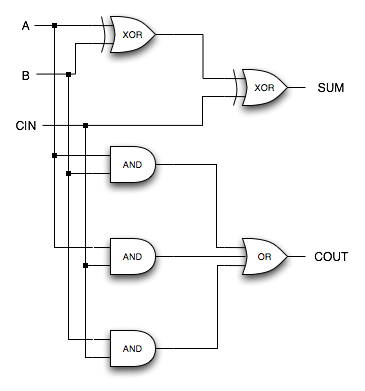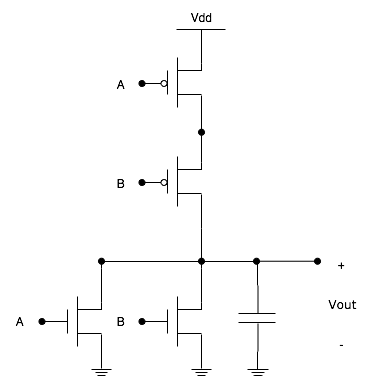Understanding the Cell Microprocessor
by Anand Lal Shimpi on March 17, 2005 12:05 AM EST- Posted in
- CPUs
Understanding Gates
The fundamental building blocks of any microprocessor are gates. Gates are collections of transistors that electrically mimic a particular logic function. For example, a 2-input AND gate will take two input signals and output a 1 only if the two inputs are both 1s. An XOR gate will output a 1 only if the two inputs are different. A NOR gate will output a 1 only if all inputs are 0s.Combinations of these gates are used to implement everything in a microprocessor, including functional units like adders, multipliers, etc.

Here, we have a 1-bit carry adder implemented using logic gates. It will add any two 1-bit numbers and produce a result.
A very popular way of designing gate logic is using what is known as static CMOS. Static CMOS designs are relatively easy to implement and there are tons of libraries available for automated (e.g. computer driven) static CMOS design. There are a couple of problems with static CMOS design:
- Static CMOS circuits aren’t the fastest circuits possible, which is why they aren’t used in things like Intel’s double-pumped ALUs where high clock speeds are necessary.
- Static CMOS designs use quite a few transistors. For each m-input gate, you need 2 * m transistors (m PMOS and m NMOS transistors), which for high fan-in gates (gates with lots of inputs), it drives transistor counts up considerably. As is the case with any heavily SIMD architecture, high fan-in gates are commonplace.

There’s another problem here - the NOR gate isn’t clocked. Normally, large collections of gates are assembled and put behind an element called a latch, which is clocked. One type of large collection would be all of the circuitry used for a pipeline stage. This isn’t really a problem for static CMOS gates, as it greatly simplifies the distribution of clocks to the chip (since you don’t have to route a clock signal to every gate, just every latch, and there are far more general gates than there are latches).
Designing and implementing static CMOS gates are extremely easy. Hardware Description Languages (HDLs), programming languages in which chips are “written” have widespread static CMOS libraries, meaning that a chip designer can focus on writing code to crank out a chip without having to hand design its circuits. But as success is usually proportional to difficulty, static CMOS designs aren’t the fastest things in the world. Things like Intel’s 7.2GHz ALUs aren’t designed using static CMOS logic, neither is Cell.










70 Comments
View All Comments
scrotemaninov - Thursday, March 17, 2005 - link
#23: True, but I believe that when the SPE's access the outside memory they go through the cache. Sure it's a lower coherancy than we're used to but it's not much worse.Houdani - Thursday, March 17, 2005 - link
18: Top Drawer Post.20: Thanks for the links!
fitten - Thursday, March 17, 2005 - link
"Given the speed of the interconnect and the fact that it is cache-coherant,"Only the PPC core has cache. The individual SPEs don't have cache - they have scratchpad RAM.
#22: I believe the PPC core is a dual issue core that just happens to be 2xSMT.
AndyKH - Thursday, March 17, 2005 - link
Great article.Anand, Could you please clarify something:
I had the impression that the PPE was a SMT processor in the sense that it had to be executing 2 threads in order to issue 2 instructions per clock. In other words: I didn't think the PPE control logic could decide to issue 2 instructions from the same thread at any given clock tick, but rather that it absolutely needed an instruction from each thread to issue two instructions.
After reading the article, I don't assume my impression is right, but a comment from you would be nice.
As I come to think about it, my impression is rather identical to 2 seperate single thread in-order cores. :-)
Koing - Thursday, March 17, 2005 - link
Cell looks VERY interesting.Any of you guys seen Devil May Cry 3 on the PS2? Looks great imo same with T5 and GT4.
Cell at first will be tough like most consoles. BUT eventually THE developers will get around it and make some very solidly good looking games.
Lets hope they are innovative and not just rehashed graphics and nothing else.
Thanks for the great article.
Koing
scrotemaninov - Thursday, March 17, 2005 - link
I really hate just dumping loads of links, but this basically is the available content on the CELL.http://arstechnica.com/articles/paedia/cpu/cell-1....
http://arstechnica.com/articles/paedia/cpu/cell-2....
http://realworldtech.com/page.cfm?ArticleID=RWT021...
http://www.blachford.info/computer/Cells/Cell0.htm...
http://www.realworldtech.com/page.cfm?ArticleID=RW...
http://www.hpcaconf.org/hpca11/papers/25_hofstee-c...
http://www.hpcaconf.org/hpca11/slides/Cell_Public_... (slides)
mrmorris - Thursday, March 17, 2005 - link
Brilliant article, there are few places for in-depth hardcore technology presentations but Anandtech never fails.scrotemaninov - Thursday, March 17, 2005 - link
Real concurrency is hard to do for the programmers. It's a real pain to get it right and it's hard to debug. Systematic analysis just gets too complex as there are just too many states, you end up with a huge graph/markov-model and it's just impossible to solve it tractably.Superscalar and SMT just try to increase ILP at the CPU level without burdening the programmer or compiler-writer. However, we've pretty much come to the end of getting a CPU to go faster - at 5GHz, LIGHT travels 6cm between clocks, and an electic PD will travel slower. As it is, in the P4 pipeline, there are at least 2 stages which are simply there to allow signals to propogate across the chip. Clearly, going faster in Hz isn't going to make the pipeline go faster.
So the ONLY thing that they can do now is to put lots of cores on the same chip and then we're going to have to deal with real concurrency. IBM/Sony are doing it now with CELL and Intel will do it in a few years. It's going to happen regardless. What we need is languages which can support real concurrency. The Java Memory Model is an almost ideal fit for the CELL, but other aspects don't work out so well, maybe. We need Pi-calculus/Join-calculus constructs in languages to be able to really deal with these cpus efficiently.
Your comments about CELL not being general purpose enough are a little wrong. IBM /already/ has the CELL in workstations and are evaluating applications that will work well. Given the speed of the interconnect and the fact that it is cache-coherant, I think we'll be seeing super-computers based on many CELLs, it's an almost ideal fit (as it is, you've almost got ccNUMA on a single chip). Also, bear in mind that this is IBM's 5th (or 6th?) generation of SMT in the PPE - they've been at it MUCH longer than Intel - IBM started it in the mid-90s around the same time that the Alpha crew were working on the EV8 which was going to have 8-way thread-level parallelism (got canned sadly).
Also, if you look at IBMs heavy CPUs - the POWER5, that has SMT and dispatches in groups of 8 instructions, not the 3/4 that AMD/Intel manage.
What I'm saying here, is that sure, the SPEs don't have BPTs of BTBs, they're all 2-way dispatch and not greater, but, they all run REALLY fast, they have short pipelines (so the pain of the branch misprediction won't be so bad), and, IBM have had software branch prediction available since the POWER4, so they've been at it a few years and must have decided that compilers really can successfully predict branch directions.
Backwards compatibility doesn't matter. Sure, Microsoft took several years to support AMD64 but that didn't stop take up of the platform - everyone just ran Linux on it (well, everyone who wanted to use the 64bit CPU they'd bought). It'll only be a few months after the CELL is out that we'll have to wait until Linux can be built on it. 100quid says Microsoft will never support it.
Frankly, considering that it's far more likely to go into super-computer or workstation environments, no one there gives a damn about backwards compatibility or Windows support. No one in those environments /wants/ a damn paper clip.
Reflex - Thursday, March 17, 2005 - link
#14: Replace 'lazy developers' with 'developers on a budget' and you will have a true statement. Its not an issue of laziness, its an issue of having the budget to optimize fully for a platform.GhandiInstinct - Thursday, March 17, 2005 - link
Wow Super CPU and SUPER RAMBUS? AHHHH!This will replace my computer. PS3 that is.